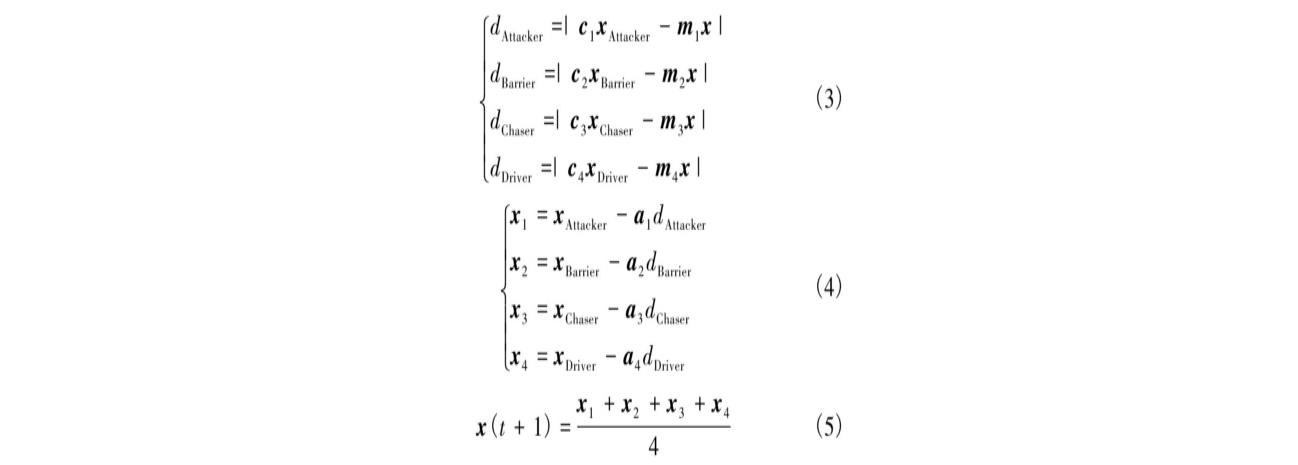单目标优化求解基于matlab增强型黑猩猩优化器算法求解单目标优化问题含Matlab源码 2013期
Posted 海神之光
tags:
篇首语:本文由小常识网(cha138.com)小编为大家整理,主要介绍了单目标优化求解基于matlab增强型黑猩猩优化器算法求解单目标优化问题含Matlab源码 2013期相关的知识,希望对你有一定的参考价值。
一、黑猩猩优化算法(ChOA)简介
1 ChOA数学描述
黑猩猩优化算法(ChOA) 是M.Khi she等人于2020年根据黑猩猩群体狩猎行为提出的一种新型元启发式优化算法。ChOA通过模拟攻击黑猩猩、驱赶黑猩猩、拦截黑猩猩和追逐黑猩猩4类黑猩猩协同狩猎行为来达到求解问题的目的。与其他算法相比, ChOA具有收敛速度快、寻优精度高等特点。
(1)驱赶和追逐猎物。
在黑猩猩狩猎过程中,通常根据黑猩猩个体智力和性动机来分配狩猎职责。任何黑猩猩均可随机改变其在猎物周围空间中的位置,数学描述为
d=|cx prey(t) -mx chimp(t) |(1)
x chimp(t+1) =X prey(t) -ad(2)
式中:d为黑猩猩与猎物间距; t为当前迭代次数; X prey(t) 为猎物位置向量; X chimp(t) 为黑猩猩位置向量; a、m、c为系数向量, a=2fr 1-f, c=2r 2, m=Chaotic_value(基于混沌映射的混沌向量) , f为迭代过程中从2.0非线性降至0, r 1、r 2为[0, 1] 范围内的随机向量。
(2)攻击方式。
黑猩猩能够探查猎物位置(通过驱赶、拦截和追逐),然后包围猎物。狩猎过程通常由攻击黑猩猩进行,驱赶黑猩猩、拦截黑猩猩和追逐黑猩猩参与狩猎过程。4类黑猩猩通过下式更新其位置,其他黑猩猩根据最佳黑猩猩位置更新其位置,猎物位置由最佳黑猩猩个体位置估计。数学描述为

式中:dAttacker、dBarrier、dChaser、dDriver分别为当前攻击黑猩猩、拦截黑猩猩、追逐黑猩猩、驱赶黑猩猩与猎物的间距;xAttacker、xBarrier、xChaser、xDriver分别为攻击黑猩猩、拦截黑猩猩、追逐黑猩猩、驱赶黑猩猩相对于猎物的位置向量;a1~a4、m1~m4、c1~c4分别为攻击黑猩猩、拦截黑猩猩、追逐黑猩猩、驱赶黑猩猩系数向量;x1、x2、x3、x4分别为攻击黑猩猩、拦截黑猩猩、追逐黑猩猩和驱赶黑猩猩位置更新向量;x为其他黑猩猩位置向量。
(3)攻击和寻找猎物。
在狩猎最后阶段,一方面黑猩猩根据攻击者、驱赶者、拦截者和追逐者位置更新位置,并攻击猎物;另一方面黑猩猩通过分散寻找猎物显示探查过程,即ChOA全局搜索。
(4)社会动机。
社会动机(性爱和修饰)会导致黑猩猩放弃其狩猎职责,这一行为有助于ChOA在求解高维问题时克服陷入局部最优和收敛速度慢等缺点。在优化过程中,通过50%的概率选择黑猩猩正常位置更新或通过混沌模型进行位置更新。数学模型表示为

式中:μ为[0,1]范围内的随机数。
二、部分源代码
close all
clear
clc
Algorithm_Name = 'I-ChoA';
N = 30; % Number of search agents
SearchAgents_no =N;
Function_name='F2'; % Name of the test function that can be from F1 to F23 (Table 1,2,3 in the paper)
Max_iteration = 500; % Maximum numbef of iterations
% Load details of the selected benchmark function
[lb,ub,dim,fobj]=Get_Functions_details(Function_name);
[ABest_scoreChimp1,ABest_posChimp1,IChoA_curve]=IChoA(SearchAgents_no,Max_iteration,lb,ub,dim,fobj);
figure('Position',[500 500 660 290])
%Draw search space
subplot(1,2,1);
func_plot(Function_name);
title('Parameter space')
xlabel('x_1');
ylabel('x_2');
zlabel([Function_name,'( x_1 , x_2 )'])
%Draw objective space
subplot(1,2,2);
semilogy(IChoA_curve,'Color','r')
title('Objective space')
xlabel('Iteration');
ylabel('Best score obtained so far');
axis tight
grid on
box on
legend('I-ChoA')
function [Attacker_score,Attacker_pos,Convergence_curve]=IChoA(N,Max_iter,lb,ub,dim,fobj)
% initialize Attacker, Barrier, Chaser, and Driver
Attacker_pos=zeros(1,dim);
Attacker_score=inf; %change this to -inf for maximization problems
Barrier_pos=zeros(1,dim);
Barrier_score=inf; %change this to -inf for maximization problems
Chaser_pos=zeros(1,dim);
Chaser_score=inf; %change this to -inf for maximization problems
Driver_pos=zeros(1,dim);
Driver_score=inf; %change this to -inf for maximization problems
%%%%%%%%%%%%%%%%%%%%%%%%%%%%%%%%%%%%%%%%%%%%%%%%%%%%%%%%%%%%%%%%%%%
lu = [lb .* ones(1, dim); ub .* ones(1, dim)]; %% =========
%%%%%%%%%%%%%%%%%%%%%%%%%%%%%%%%%%%%%%%%%%%%%%%%%%%%%%%%%%%%%%%%%%%%%
%Initialize the positions of search agents
Positions=initialization(N,dim,ub,lb);
%============================================================
Positions = boundConstraint (Positions, Positions, lu); %% =====
% Calculate objective function for each champ
for i=1:size(Positions,1)
Fit(i) = fobj(Positions(i,:));
end
% Personal best fitness and position obtained by each champ
pBestScore = Fit;
pBest = Positions;
neighbor = zeros(N,N);
%%=======================================================================
Convergence_curve=zeros(1,Max_iter);
l=0;% Loop counter
%%
% Main loop
while l<Max_iter
for i=1:size(Positions,1)
%%=========================================
fitness = Fit(i);
% Update Attacker, Barrier, Chaser, and Driver
if fitness<Attacker_score
Attacker_score=fitness; % Update Attacker
Attacker_pos=Positions(i,:);
end
if fitness>Attacker_score && fitness<Barrier_score
Barrier_score=fitness; % Update Barrier
Barrier_pos=Positions(i,:);
end
if fitness>Attacker_score && fitness>Barrier_score && fitness<Chaser_score
Chaser_score=fitness; % Update Chaser
Chaser_pos=Positions(i,:);
end
if fitness>Attacker_score && fitness>Barrier_score && fitness>Chaser_score && fitness>Driver_score
Driver_score=fitness; % Update Driver
Driver_pos=Positions(i,:);
end
end
f=2-l*((2)/Max_iter); % a decreases linearly fron 2 to 0
% The Dynamic Coefficient of f Vector as Table 1.
%Group 1
C1G1=1.95-((2*l^(1/3))/(Max_iter^(1/3)));
C2G1=(2*l^(1/3))/(Max_iter^(1/3))+0.5;
%Group 2
C1G2= 1.95-((2*l^(1/3))/(Max_iter^(1/3)));
C2G2=(2*(l^3)/(Max_iter^3))+0.5;
%Group 3
C1G3=(-2*(l^3)/(Max_iter^3))+2.5;
C2G3=(2*l^(1/3))/(Max_iter^(1/3))+0.5;
%Group 4
C1G4=(-2*(l^3)/(Max_iter^3))+2.5;
C2G4=(2*(l^3)/(Max_iter^3))+0.5;
% Update the Position of search agents including omegas
for i=1:size(Positions,1)
for j=1:size(Positions,2)
%
%
%% Please note that to choose a other groups you should use the related group strategies
r11=C1G1*rand(); % r1 is a random number in [0,1]
r12=C2G1*rand(); % r2 is a random number in [0,1]
r21=C1G2*rand(); % r1 is a random number in [0,1]
r22=C2G2*rand(); % r2 is a random number in [0,1]
r31=C1G3*rand(); % r1 is a random number in [0,1]
r32=C2G3*rand(); % r2 is a random number in [0,1]
r41=C1G4*rand(); % r1 is a random number in [0,1]
r42=C2G4*rand(); % r2 is a random number in [0,1]
A1=2*f*r11-f; % Equation (3)
C1=2*r12; % Equation (4)
%% % Please note that to choose various Chaotic maps you should use the related Chaotic maps strategies
m=chaos(3,1,1); % Equation (5)
D_Attacker=abs(C1*Attacker_pos(j)-m*Positions(i,j)); % Equation (6)
X1=Attacker_pos(j)-A1*D_Attacker; % Equation (7)
A2=2*f*r21-f; % Equation (3)
C2=2*r22; % Equation (4)
D_Barrier=abs(C2*Barrier_pos(j)-m*Positions(i,j)); % Equation (6)
X2=Barrier_pos(j)-A2*D_Barrier; % Equation (7)
A3=2*f*r31-f; % Equation (3)
C3=2*r32; % Equation (4)
D_Driver=abs(C3*Chaser_pos(j)-m*Positions(i,j)); % Equation (6)
X3=Chaser_pos(j)-A3*D_Driver; % Equation (7)
A4=2*f*r41-f; % Equation (3)
C4=2*r42; % Equation (4)
D_Driver=abs(C4*Driver_pos(j)-m*Positions(i,j)); % Equation (6)
X4=Chaser_pos(j)-A4*D_Driver; % Equation (7)
X_Chimp(i,j)=(X1+X2+X3+X4)/4;% Equation (8)
end
X_Chimp(i,:) = boundConstraint(X_Chimp(i,:), Positions(i,:), lu);
Fit_Chimp(i) = fobj(X_Chimp(i,:));
end
%% Calculate the candiadate position Xi-DLH
radius = pdist2(Positions, X_Chimp, 'euclidean'); % Equation (10)
dist_Position = squareform(pdist(Positions));
r1 = randperm(N,N);
for t=1:N
neighbor(t,:) = (dist_Position(t,:)<=radius(t,t));
[~,Idx] = find(neighbor(t,:)==1); % Equation (11)
random_Idx_neighbor = randi(size(Idx,2),1,dim);
for d=1:dim
X_DLH(t,d) = Positions(t,d) + rand .*(Positions(Idx(random_Idx_neighbor(d)),d)...
- Positions(r1(t),d)); % Equation (12)
end
X_DLH(t,:) = boundConstraint(X_DLH(t,:), Positions(t,:), lu);
Fit_DLH(t) = fobj(X_DLH(t,:));
end
%% Selection
tmp = Fit_Chimp < Fit_DLH; % Equation (13)
tmp_rep = repmat(tmp',1,dim);
tmpFit = tmp .* Fit_Chimp + (1-tmp) .* Fit_DLH;
tmpPositions = tmp_rep .* X_Chimp + (1-tmp_rep) .* X_DLH;
%% Updating
tmp = pBestScore <= tmpFit; % Equation (13)
tmp_rep = repmat(tmp',1,dim);
pBestScore = tmp .* pBestScore + (1-tmp) .* tmpFit;
pBest = tmp_rep .* pBest + (1-tmp_rep) .* tmpPositions;
Fit = pBestScore;
Positions = pBest;
%%
l = l+1;
neighbor = zeros(N,N);
Convergence_curve(l